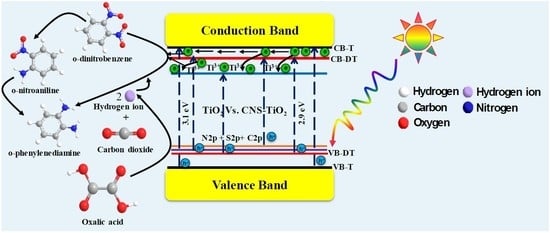Highly Selective Photocatalytic Reduction of o-Dinitrobenzene to o-Phenylenediamine over Non-Metal-Doped TiO2 under Simulated Solar Light Irradiation
Abstract
:1. Introduction
2. Results and Discussion
2.1. Reduction of O-Dinitrobenzene to O-Nitroaniline and O-Phenylenediamine
2.2. Materials and Chemicals
2.3. Photocatalysts Preparation
2.4. Sample Characterization
2.5. Photocatalytic Reaction Procedure
3. Conclusions
Supplementary Materials
Author Contributions
Funding
Acknowledgments
Conflicts of Interest
References
- Ferry, J.L.; Glaze, W.H. Photocatalytic reduction of nitro organics over illuminated titanium dioxide: Role of the TiO2 surface. Langmuir 1998, 14, 3551–3557. [Google Scholar] [CrossRef]
- Shiraishi, Y.; Hirai, T. Selective organic transformations on titanium oxide-based photocatalysts. J. Photochem. Photobiol. C Photochem. Rev. 2008, 9, 157–170. [Google Scholar] [CrossRef]
- Wang, H.; Yan, J.; Chang, W.; Zhang, Z.; Wang, H. Practical synthesis of aromatic amines by photocatalytic reduction of aromatic nitro compounds on nanoparticles N-doped TiO2. Catal. Commun. 2009, 10, 989–994. [Google Scholar] [CrossRef]
- Imamura, K.; Iwasaki, S.; Maeda, T.; Hashimoto, K.; Ohtani, B.; Kominami, H. Photocatalytic reduction of nitrobenzenes to aminobenzenes in aqueous suspensions of titanium (IV) oxide in the presence of hole scavengers under deaerated and aerated conditions. Phys. Chem. Chem. Phys. 2011, 13, 5114–5119. [Google Scholar] [CrossRef] [PubMed]
- Hakki, A.; Dillert, R.; Bahnemann, D.W. Photocatalysis as an Auspicious Synthetic Route towards Nitrogen Containing Organic Compounds. Curr. Org. Chem. 2013, 17, 2482–2502. [Google Scholar] [CrossRef]
- Ragaini, F.; Cenini, S.; Gasperini, M. Reduction of nitrobenzene to aniline by CO/H2O, catalysed by Ru3(CO)12/chelating diimines. J. Mol. Catal. A Chem. 2001, 174, 51–57. [Google Scholar] [CrossRef]
- Longo, C.; Alvarez, J.; Fernández, M.; Pardey, A.J.; Moya, S.A.; Baricelli, P.; Mdleleni, M.M. Water as hydride source in the reduction of nitrobenzene to aniline catalyzed by cis-[Rh(CO)2(2-picoline)2](PF6) in aqueous 2-picoline under CO atmosphere: Kinetics study. Polyhedron 2000, 19, 487–493. [Google Scholar] [CrossRef]
- Blaser, H.-U.; Steiner, H.; Studer, M. Selective Catalytic Hydrogenation of Functionalized Nitroarenes: An Update. ChemCatChem. 2009, 1, 210–221. [Google Scholar] [CrossRef]
- Mahdavi, F.; Bruton, T.C.; Li, Y. Photoinduced reduction of nitro compounds on semiconductor particles. J. Org. Chem. 1993, 58, 744–746. [Google Scholar] [CrossRef]
- Tada, H.; Ishida, T.; Takao, A.; Ito, S. Drastic enhancement of TiO2-photocatalyzed reduction of nitrobenzene by loading Ag clusters. Langmuir 2004, 20, 7898–7900. [Google Scholar] [CrossRef]
- Li, Y.; Wasgestian, F. Photocatalytic reduction of nitrate ions on TiO2 by oxalic acid. J. Photochem. Photobiol. A 1998, 112, 255–259. [Google Scholar] [CrossRef]
- Kominami, H.; Nakaseko, T.; Shimada, Y.; Furusho, A.; Inoue, H.; Murakami, S.; Kera, Y.; Ohtani, B. Selective photocatalytic reduction of nitrate to nitrogen molecules in an aqueous suspension of metal-loaded titanium (IV) oxide particles. Chem. Commun. 2005, 23, 2933–2935. [Google Scholar] [CrossRef] [PubMed]
- Kominami, H.; Furusho, A.; Murakami, S.; Inoue, H.; Kera, Y.; Ohtani, B. Effective Photocatalytic Reduction of Nitrate to Ammonia in an Aqueous Suspension of Metal Loaded Titanium (IV) Oxide Particles in the Presence of Oxalic Acid. Catal. Lett. 2001, 76, 31–34. [Google Scholar] [CrossRef]
- Zand, Z.; Kazemi, F.; Hosseini, S. Development of chemoselective photoreduction of nitro compounds under solar light and blue LED irradiation. Tetrahedron Lett. 2014, 55, 338–341. [Google Scholar] [CrossRef]
- Shiraishi, Y.; Togawa, Y.; Tsukamoto, D.; Tanaka, S.; Hirai, T. Highly efficient and selective hydrogenation of nitroaromatics on photoactivated rutile titanium dioxide. ACS Catal. 2012, 2, 2475–2481. [Google Scholar] [CrossRef]
- Kaur, J.; Pal, B. 100% selective yield of m-nitroaniline by rutile TiO2 and m-phenylenediamine by P25-TiO2 during m-dinitrobenzene photoreduction. Catal. Commun. 2014, 53, 25–28. [Google Scholar] [CrossRef]
- El-Sheikh, S.M.; Zhang, G.; El-Hosainy, H.M.; Ismail, A.A.; Dionysiou, D.D. High performance, sulfur, nitrogen and carbon doped mesoporous anatase-brookite TiO2 photocatalyst for the removal of microcystin-LR under visible light irradiation. J. Hazard. Mater. 2014, 280, 723–733. [Google Scholar] [CrossRef]
- Hakki, A.; Dillert, R.; Bahnemann, D. Photocatalytic conversion of nitroaromatic compounds in the presence of TiO2. Catal. Today 2009, 144, 154–159. [Google Scholar] [CrossRef]
- Wang, J.; Li, H.; Li, H.; Zou, C. Mesoporous TiO2−xAy (A = N, S) as a visible-light-response photocatalyst. Solid State Sci. 2010, 12, 490–497. [Google Scholar] [CrossRef]
- Etacheri, V.; Seery, M.K.; Hinder, S.J.; Pillai, S.C. Highly Visible Light Active TiO2−xNx Heterojunction Photocatalysts. Chem. Mater. 2010, 22, 3843–3853. [Google Scholar] [CrossRef]
- Justicia, I.; Ordejon, P.; Canto, G.; Mozos, J.L.; Fraxedes, J.; Battiston, G.A. Designed Self-Doped Titanium Oxide Thin Films for Efficient Visible-Light Photocatalysis. Adv. Mater. 2002, 14, 1399–1402. [Google Scholar] [CrossRef]
- Yang, G.; Jiang, Z.; Shi, H.; Xiao, T.; Yan, Z. Preparation of highly visible-light active N-doped TiO2 photocatalyst. J. Mater. Chem. 2010, 20, 5301–5309. [Google Scholar] [CrossRef]
- Xiong, L.-B.; Li, J.-L.; Yang, B.; Yu, Y. Ti3+ in the surface of titanium dioxide: Generation, properties and photocatalytic application. J. Nanometer. 2012, 2012. [Google Scholar] [CrossRef]
- Tan, H.; Zhao, Z.; Niu, M.; Mao, C.; Cao, D.; Cheng, D.; Feng, P.; Sun, Z. A facile and versatile method for preparation of colored TiO2 with enhanced solar-driven photocatalytic activity. Nanoscale 2014, 6, 10216–10223. [Google Scholar] [CrossRef] [PubMed]
- Yan, Y.; Han, M.; Konkin, A.; Koppe, T.; Wang, D.; Andreu, T.; Chen, G.; Vetter, U.; Ramon Morante, J.; Schaaf, P. Slightly hydrogenated TiO2 with enhanced photocatalytic performance. J. Mater. Chem. A 2014, 2, 12708–12716. [Google Scholar] [CrossRef]
- Grabstanowicz, L.R.; Gao, S.; Li, T.; Rickard, R.M.; Rajh, T.; Liu, D.-J.; Xu, T. Facile oxidative conversion of TiH2 to high-concentration Ti3+-self-doped rutile TiO2 with visible-light photoactivity. Inorg. Chem. 2013, 52, 3884–3892. [Google Scholar] [CrossRef] [PubMed]
- Bahnemann, D.; Henglein, A.; Lilie, J.; Spanhel, L. Flash photolysis observation of the absorption spectra of trapped positive holes and electrons in colloidal titanium dioxide. J. Phys. Chem. 1984, 88, 709–711. [Google Scholar] [CrossRef]
- Li, D.; Jia, J.; Zheng, T.; Cheng, X.; Yu, X. Construction and characterization of visible light active Pd nano-crystallite decorated and C-N-S-co-doped TiO2 nanosheet array photoelectrode for enhanced photocatalytic degradation of acetylsalicylic acid. Appl. Catal. B 2016, 188, 259–271. [Google Scholar] [CrossRef]
- Kaur, J.; Singh, R.; Pal, B. Influence of coinage and platinum group metal co-catalysis for the photocatalytic reduction of m-dinitrobenzene by P25 and rutile TiO2. J. Mol. Catal. A Chem. 2015, 397, 99–105. [Google Scholar] [CrossRef]
- Schneider, J.; Nikitin, K.; Wark, M.; Bahnemann, D.W.; Marschall, R. Improved charge carrier separation in barium tantalate composites investigated by laser flash photolysis. Phys. Chem. Chem. Phys. 2016, 18, 10719–10726. [Google Scholar] [CrossRef] [Green Version]
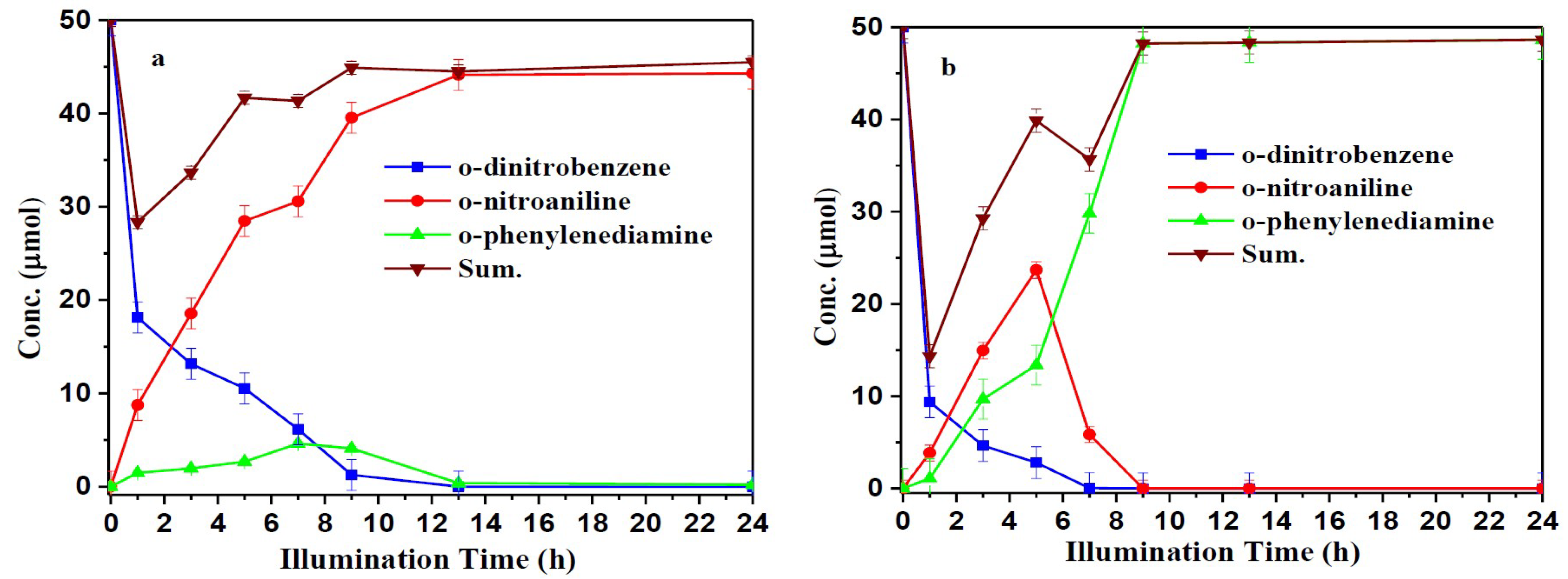

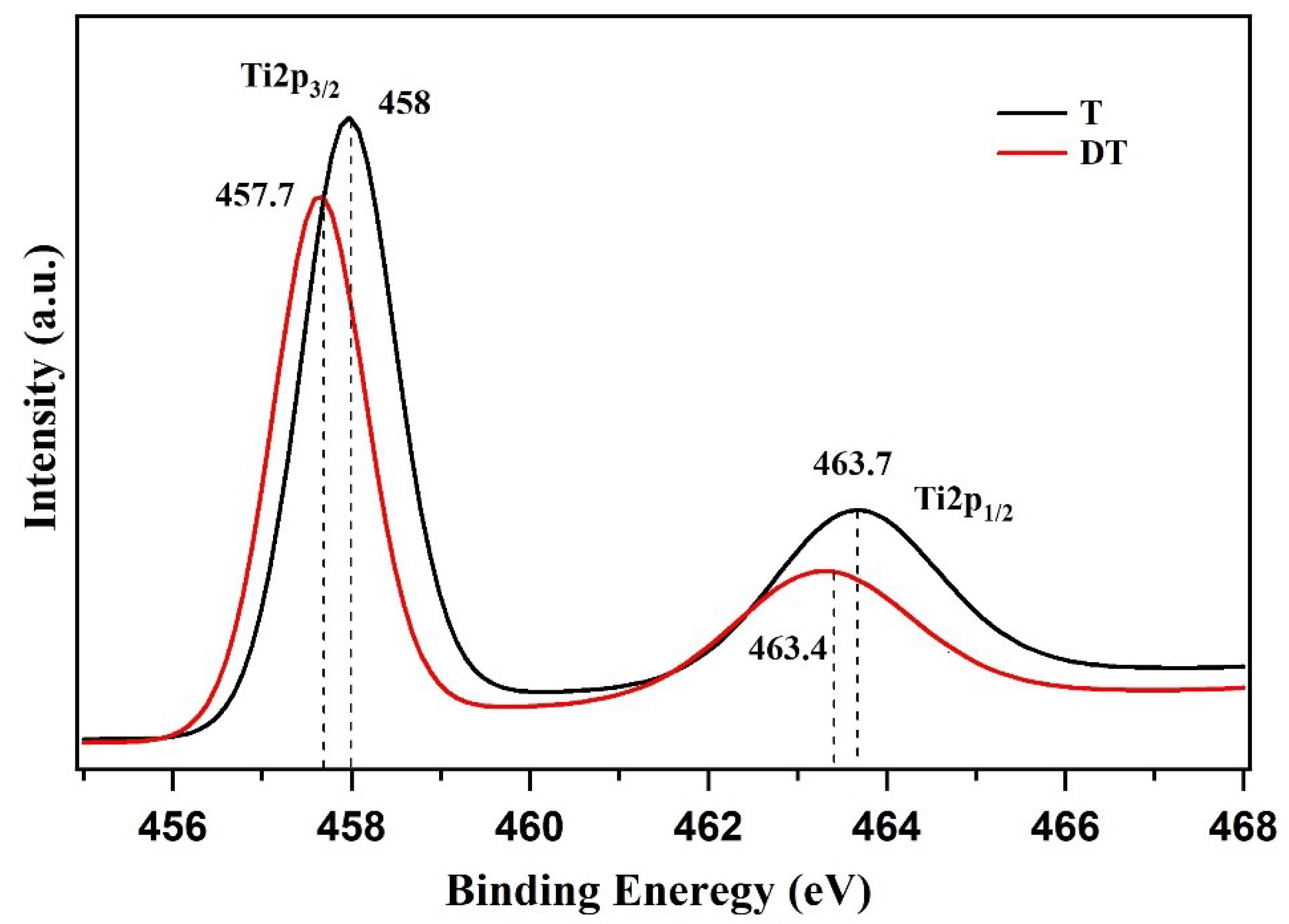
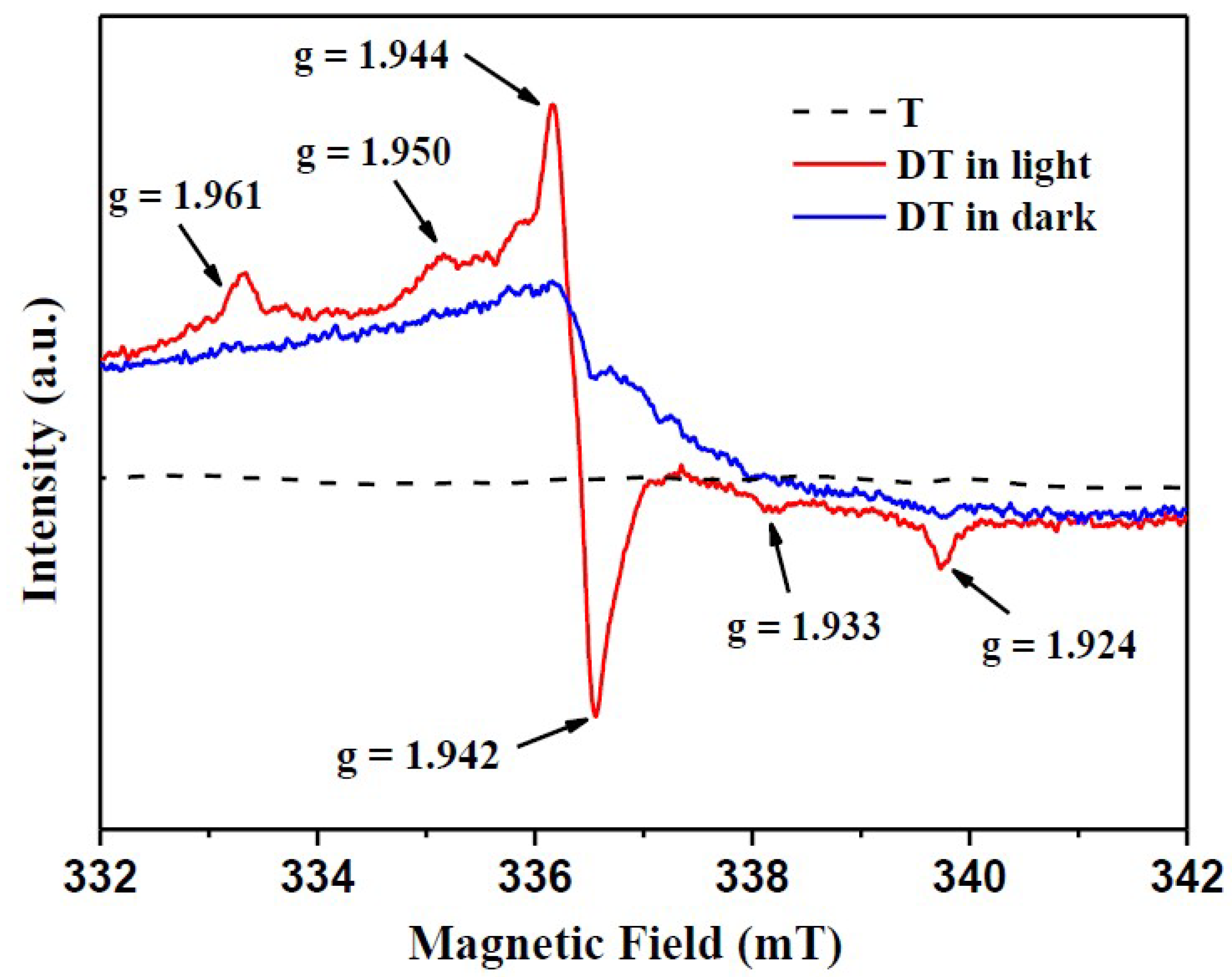

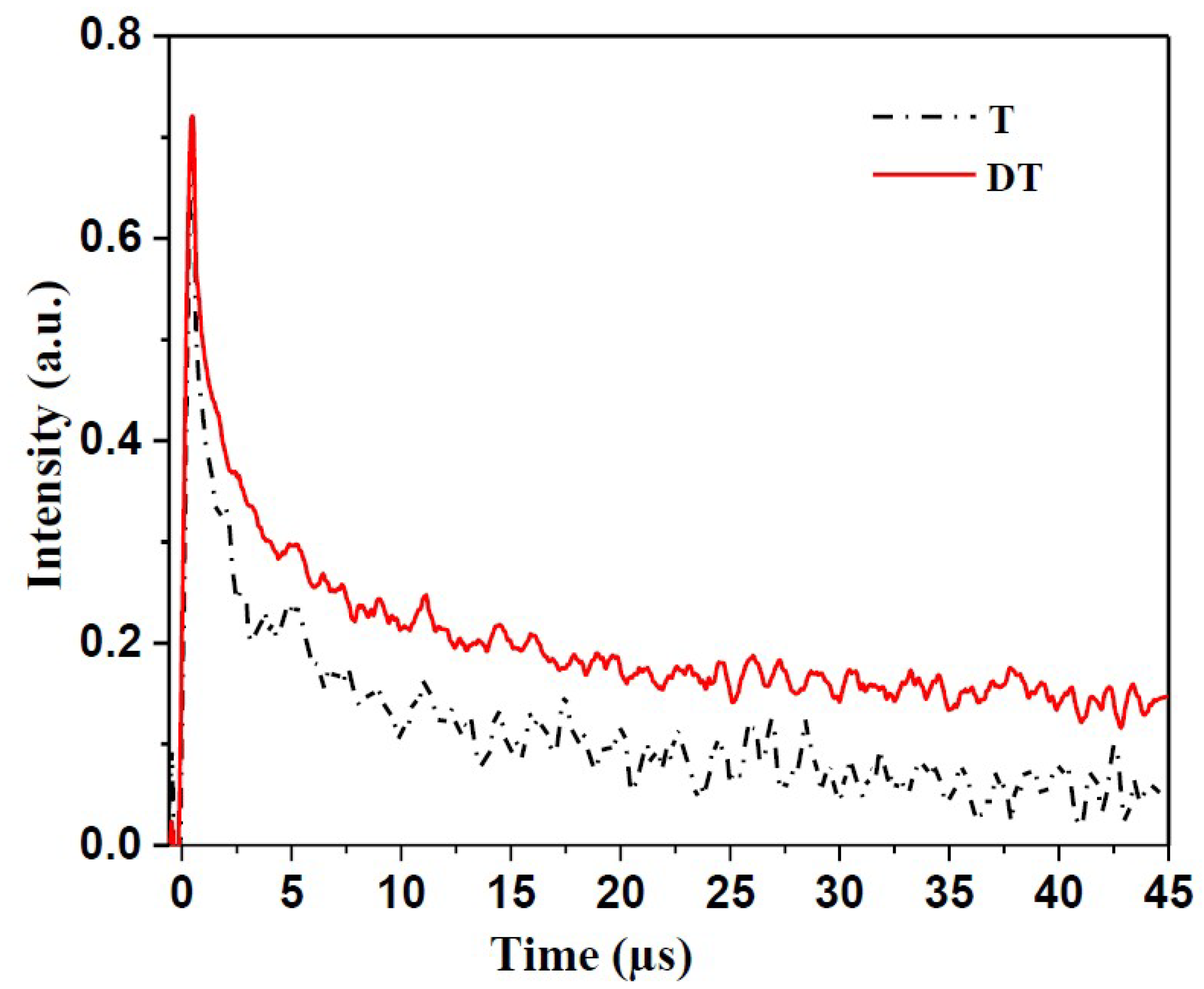
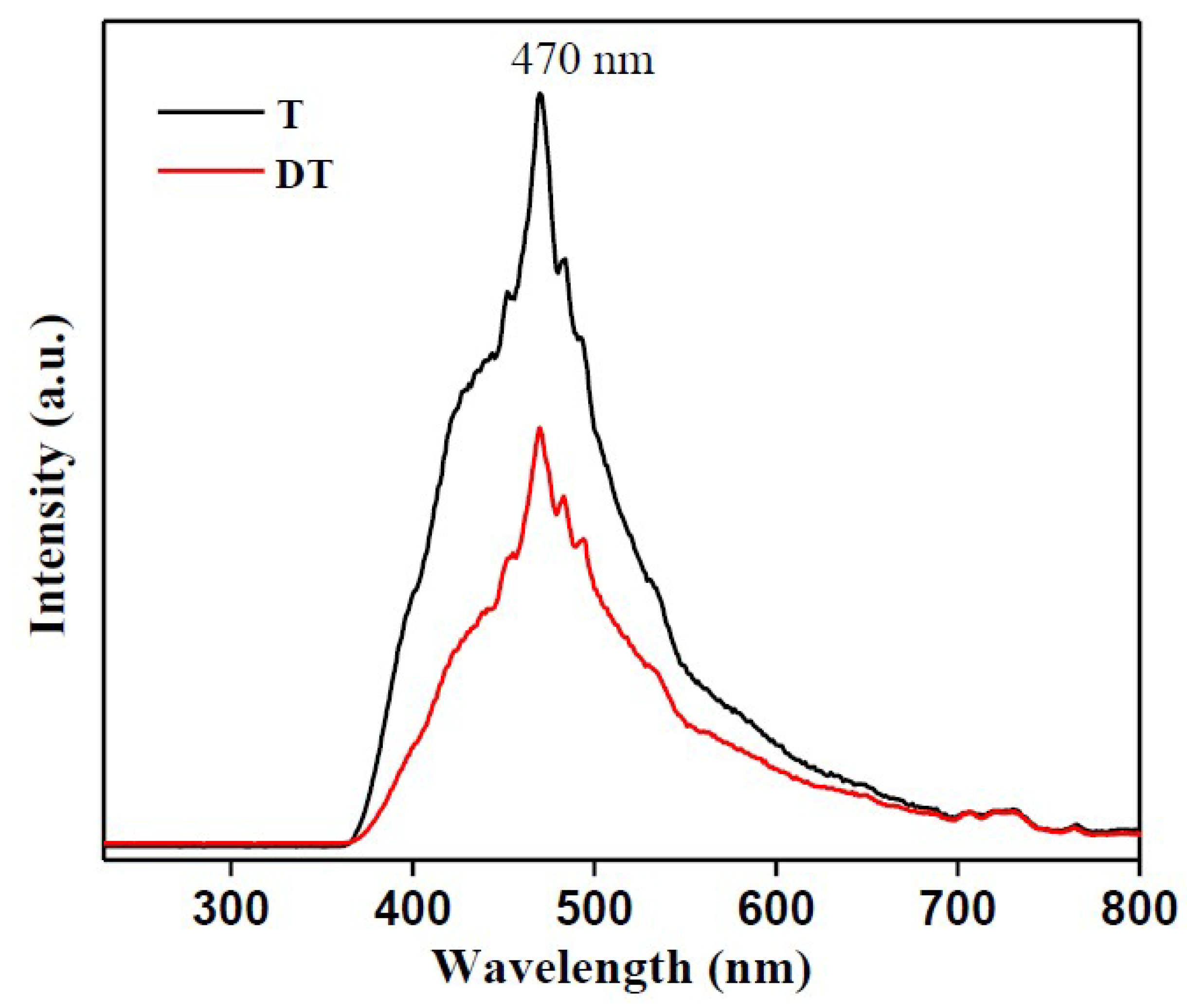
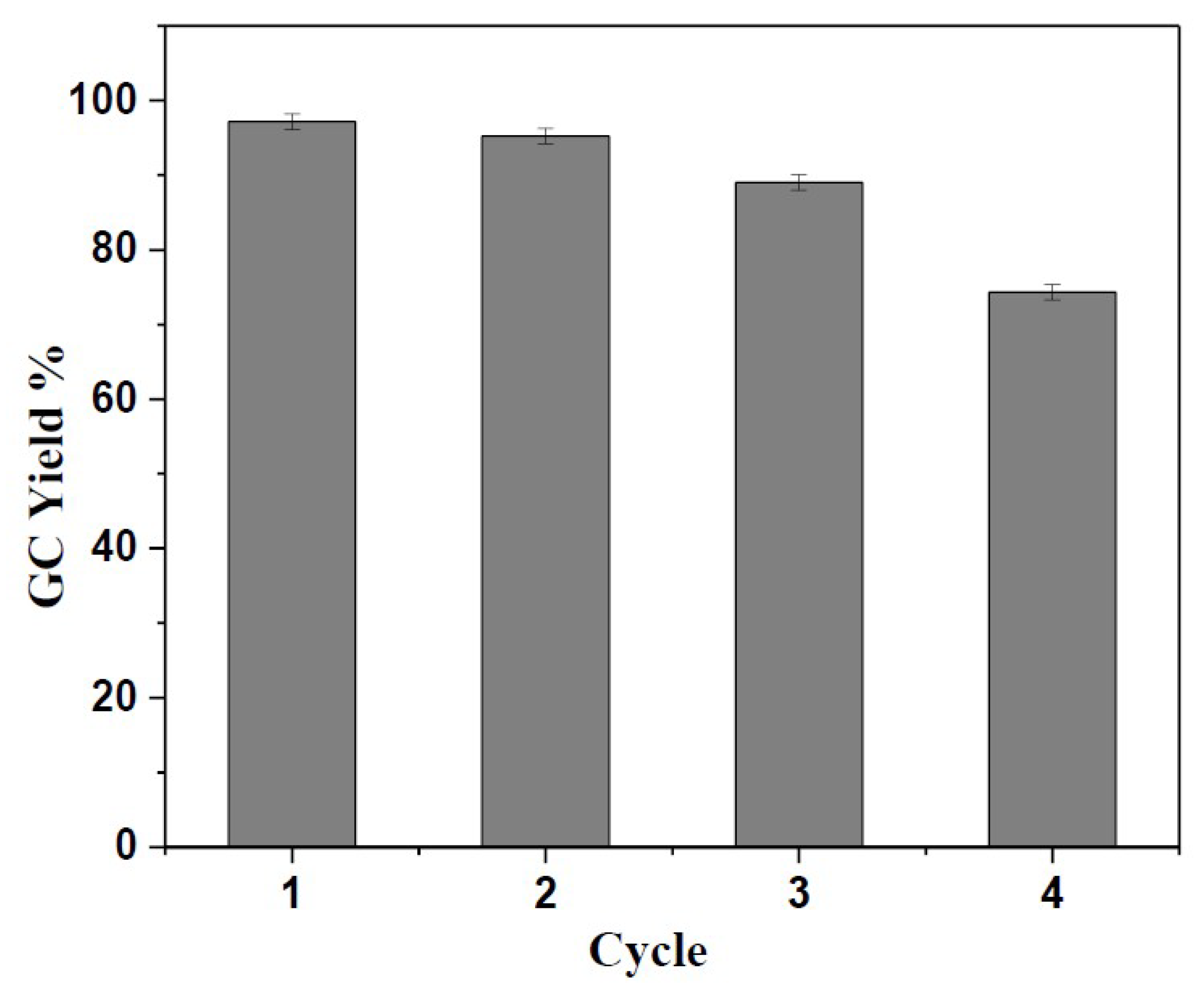
© 2018 by the authors. Licensee MDPI, Basel, Switzerland. This article is an open access article distributed under the terms and conditions of the Creative Commons Attribution (CC BY) license (http://creativecommons.org/licenses/by/4.0/).
Share and Cite
El-Hosainy, H.M.; El-Sheikh, S.M.; Ismail, A.A.; Hakki, A.; Dillert, R.; Killa, H.M.; Ibrahim, I.A.; Bahnemann, D.W. Highly Selective Photocatalytic Reduction of o-Dinitrobenzene to o-Phenylenediamine over Non-Metal-Doped TiO2 under Simulated Solar Light Irradiation. Catalysts 2018, 8, 641. https://doi.org/10.3390/catal8120641
El-Hosainy HM, El-Sheikh SM, Ismail AA, Hakki A, Dillert R, Killa HM, Ibrahim IA, Bahnemann DW. Highly Selective Photocatalytic Reduction of o-Dinitrobenzene to o-Phenylenediamine over Non-Metal-Doped TiO2 under Simulated Solar Light Irradiation. Catalysts. 2018; 8(12):641. https://doi.org/10.3390/catal8120641
Chicago/Turabian StyleEl-Hosainy, Hamza M., Said M. El-Sheikh, Adel A. Ismail, Amer Hakki, Ralf Dillert, Hamada M. Killa, Ibrahim A. Ibrahim, and Detelf W. Bahnemann. 2018. "Highly Selective Photocatalytic Reduction of o-Dinitrobenzene to o-Phenylenediamine over Non-Metal-Doped TiO2 under Simulated Solar Light Irradiation" Catalysts 8, no. 12: 641. https://doi.org/10.3390/catal8120641
APA StyleEl-Hosainy, H. M., El-Sheikh, S. M., Ismail, A. A., Hakki, A., Dillert, R., Killa, H. M., Ibrahim, I. A., & Bahnemann, D. W. (2018). Highly Selective Photocatalytic Reduction of o-Dinitrobenzene to o-Phenylenediamine over Non-Metal-Doped TiO2 under Simulated Solar Light Irradiation. Catalysts, 8(12), 641. https://doi.org/10.3390/catal8120641





